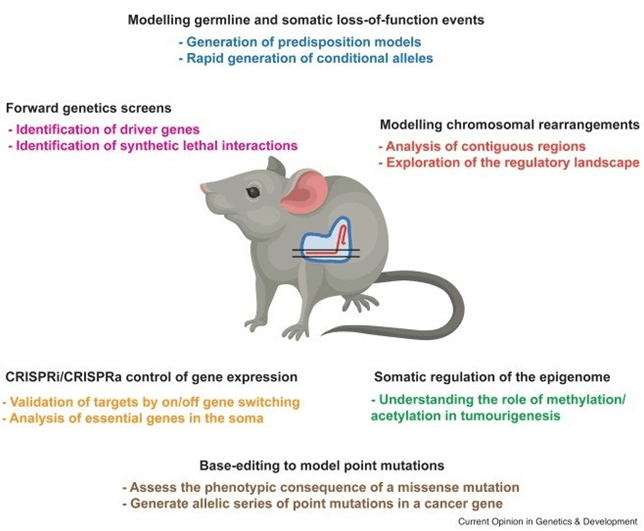Qualified animal models can simulate the pathological processes of clinical diseases, and the application of gene-editing technology to establish animal models can more accurately and completely reproduce the pathological characteristics.
 Figure 1. The ways that CRISPR/Cas9-gene editing may be used to understand cancer gene function in mice. (Louise van der W, et al. 2021)
Figure 1. The ways that CRISPR/Cas9-gene editing may be used to understand cancer gene function in mice. (Louise van der W, et al. 2021)
Genetically modified animal models are indispensable tools in basic and applied scientific research, and the improvement of their construction methods has never stopped. From the most classical ES cell-mediated homologous recombination to various DNA endonuclease systems, such as TALEN, ZFN, and CRISPR/Cas9, have been successively used for the construction of genetically modified animal models. CRISPR/Cas9 gene-editing technology is becoming the mainstream technology for genomic genetic modification because of its high specificity, easy and fast construction, low cost, and short experimental cycle.
Lifeasible applied CRISPR/Cas9 gene-editing technology to establish gene editing animal models, which can more accurately and completely reproduce the relevant pathological features. We have successfully performed conditional knockout of mouse Alk1, FAD3, FcγR, PDE5, RNA-101a, FGFR2, and other genes to establish mouse gene editing animal models, and can detect lesion formation. We can provide gene editing animal model construction services for the clinical selection of effective therapeutic and preventive drugs.

AVM is a common cause of spontaneous cerebral hemorrhage and is the leading cause of cerebral hemorrhage in adolescents. Currently, despite some progress in basic research on cerebral AVM, there are still many questions to be addressed. Therefore, the gene-editing mouse model we provide can help the clinic to understand the pathogenesis of AVM in detail and explore effective prevention and treatment measures.
The FcγR gene family is widely expressed in the hematopoietic system and has important roles in regulating several aspects of humoral immune tolerance and antibody-dependent cellular immune responses, and its abnormal expression is associated with a variety of autoimmune diseases. We have used CRISPR/Cas9 technology to knock out this gene cluster and obtain stable passages to facilitate our clients' research on immune diseases associated with this gene.
PDE5 is an important target for many diseases, and it is of great importance to study the changes that occur after the deletion of the PDE5 gene. We can use CRISPR/Cas9 gene-editing technology to establish a PDE5 knockout mouse model and analyze the phenotype, initially observe the effect of PDE5 knockout on various vital indicators of mice, and provide our customers with a gene-editing mouse model to further study the pathophysiological mechanism of PDE5 in various diseases.
AS is a genetic disease caused by single-gene mutations, mainly caused by the FGFR2 Ser252Trp (S252W) or pro253Arg (P253R) function-enhancing point mutations in FGFR2. We used CRISPR/Cas9 to target the FGFR2 gene, and mice showed a significant improvement in the premature closure of the coronal suture, which also suggests that we can alleviate the abnormal state of the AS mouse head using CRISPR/Cas9 gene editing.
References